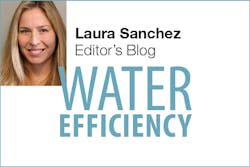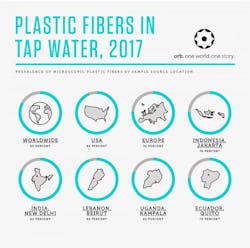We’ve all seen pictures of the garbage patch cluttering the ocean’s gyres. We’ve been warned that microplastics are filling the bellies of fish that we consume. But what about our drinking water? Could the water from the world’s taps be creating flotsam in our veins?
Microplastics—those tiny fibers and fragments that float off your fleece and flake from your fence—are abundant in the world’s drinking water, a new study finds, and they’re accumulating in our bodies.
The levels of plastic prevalence differed from place to place, as shown in the infographic, but over 70% of the tap water samples they collected revealed the presence of plastics. In the US, the study found that 94% of all water samples—including tap water from the Environmental Protection Agency’s headquarters—were contaminated by plastic.
Scientists indicate that plastic fibers are in our foods as well. “Chemicals from plastics are a constant part of our daily diet,” Scott Belcher, Ph.D., a research professor at North Carolina State University, told the study’s authors; “…these plastics are breaking down and leaching chemicals, including endocrine-disrupting plasticizers like BPA or phthalates, flame retardants, and even toxic heavy metals that are all absorbed into our diets and bodies.”
Microscopic plastics can enter the water system in a myriad of ways, the researchers explain, from synthetic clothing fibers to tire dust, airborne particles, microbeads, and broken-down pieces of bags, straws, and bottles. An estimated one million tons of synthetic fibers make their way to water sources just through washing synthetic clothing each year. It’s insidious stuff that never breaks down, and it can be challenging to filter out.
Sherri A. Mason, PhD., Chair of the Department of Geology and Environmental Sciences at The State University of New York at Fredonia, told Orb, “There are certain commons that connect us all to each other: air, water, soil, and what we have universally found time and time again is if you contaminate any of those commons, it gets in everything.”
What solutions can you recommend? What policies and protections do you feel should be put in place?

